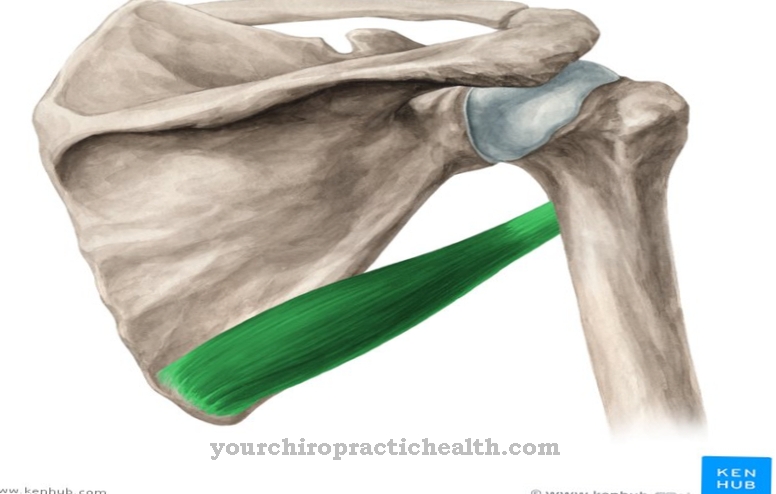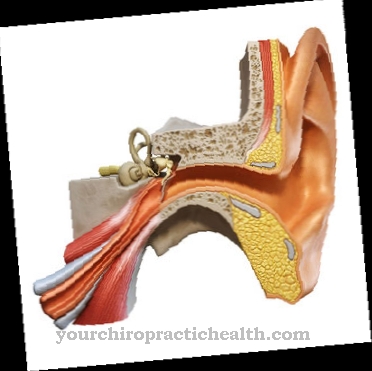The Spongiosa substantia is the inner, bony network of the bone substance. Above all, it determines the load-bearing capacity of the bones. In osteoporosis, the cancellous bone is increasingly broken down and the bone loses its load-bearing capacity.
What is the substantia cancellous?
The human Bone tissue In its macroscopic form, it is also known as the substantia spongiosa. This spongy substance consists of fine trabeculae. The macroscopic bone platelets are known as such.
The macroscopic structure of the bone tissue is also known as cancellous bone for short. In the case of flat bones, on the other hand, diploë is sometimes used instead of cancellous bone. The so-called braided bone, which arises at the beginning of osteogenesis, must be distinguished from these macroscopic bone forms. The woven bones are made from cartilage or are formed directly from stem cells of the connective tissue. Like the cancellous bone, braided bones have fine bone beams.
The bars of the cancellous bone are not directly intertwined and, unlike those of the braided bone, do not form a structurally organized whole. In addition to the substantia cancellous bone on the inside, the bone is mainly formed by the substantia compacta on the outside, which, unlike the adaptable cancellous bone, is rather static and corresponds to the stable part of the bone.
Anatomy & structure
The cancellous bone is located within the bones. On the outside, the substance is surrounded by the cortex. The bone marrow lies within the cavities between the individual cancellous bars. Overall, the cancellous bone corresponds to an extremely tightly networked framework.
The bars of the cancellous bone are connected to one another and form a grid-like structure. Many of the trabeculae lie within the cancellous bone, especially along the load lines of individual bones. Stress trajectories are often used in this context. The architecture of the cancellous bone strongly depends on the pressure conditions in the bone. If a certain section of the bone is exposed to excessive pressure, for example, the cancellous bone adapts to the pressure requirements in this area.
The same applies to bending or torsional forces, such as those that act on the femoral head. Due to its lightweight construction principle, the cancellous bone saves bone substance and thus ensures the minimal weight of the bones.
Function & tasks
In osteogenesis, the first thing that is formed is the braided bone. In chondral osteogenesis, osteoblasts form the woven bone made of cartilage. This ossification is indirect. In direct ossification, the woven bone is created by the bone-building osteoblasts directly from the stem cells of the connective tissue.
For this reason the process is referred to as direct or desmal osteogenesis. There is a compaction of the substance on the surface of each braided bone. In addition, additional bone substance accumulates from the outside in the course of osteogenesis. This substance corresponds to the cortex. Inside, the bone substance is converted into cancellous bone. The bone-degrading osteoclasts are involved in this remodeling work. They break down parts of the bone matrix, while osteoblasts rebuild bone material at the same time.
The characteristic bone bars of the cancellous bone arise from the work of the osteoblasts. The resulting lattice structure adapts dynamically and lifelong to the new loads on the individual bones after the osteogenesis work is complete. The function of the cancellous bone thus primarily corresponds to bone stabilization and bone adaptation to changed loads. The cancellous bone is therefore particularly responsible for the load-bearing capacity of a bone.
Diseases
One of the most important diseases of the substantia spongiosa is osteoporosis. Osteoporosis is a pathological loss of bone material that far exceeds the physiologically normal bone loss in the course of the natural aging process.
The normal aging process usually does not break down more than half of the existing bone mass and begins at the age of 30. Vertebral fractures only occur during normal aging processes when a corresponding accident occurs. In patients with osteoporosis, vertebral fractures occur even without external influence. Unlike old age atrophy, osteoporosis breaks down all parts of the bone. The spongy substance of the bones in particular is affected by osteoporosis. This significantly reduces the load-bearing capacity of the individual bones. For a long time, the onset of osteoporosis does not cause any symptoms.
The breakdown of bone progresses slowly and at a certain point causes atypical bone fractures. The fractures preferentially occur on the vertebral bodies in the lower back. Either they are preceded by slight bumps or they occur without any identifiable cause. A vertebral fracture causes pain to the patient, which is often perceived as diffuse, vaguely localized pain. The vertebral fractures deform the spine and create what is known as a widow's hump. Sometimes the height also decreases by a few centimeters. Patients are more prone to fractures than healthy people of the same age and therefore often suffer from fractures in the femur after a trivial household accident, for example.
Depending on its causes, osteoporosis is divided into two types. Primary osteoporosis occurs without the influence of chronic diseases. In addition to old age, genetic components are discussed as the cause of occurrence. The consumption of alcohol, coffee and cigarettes can negatively influence and accelerate the course of the disease. A lack of exercise also plays a role in primary osteoporosis. The same applies to insufficient absorption of calcium or vitamin D. Secondary osteoporosis occurs as part of chronic diseases or is triggered by certain medications. Hormonal imbalances, sugar disorders, and intestinal disorders are often related to the outbreak.
























.jpg)



